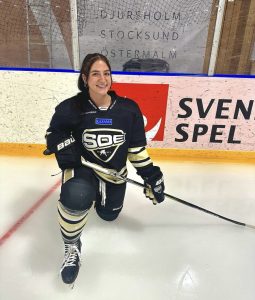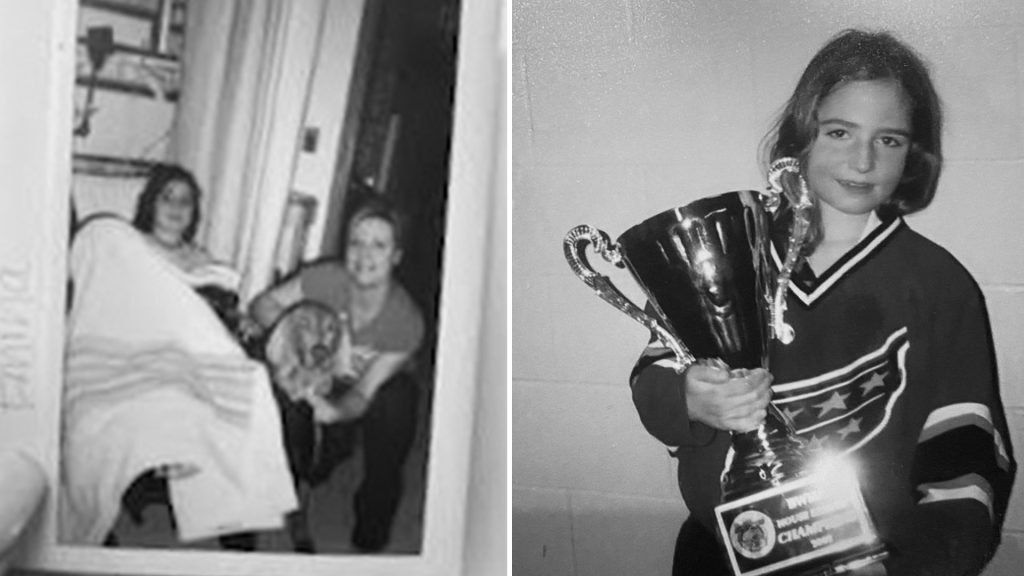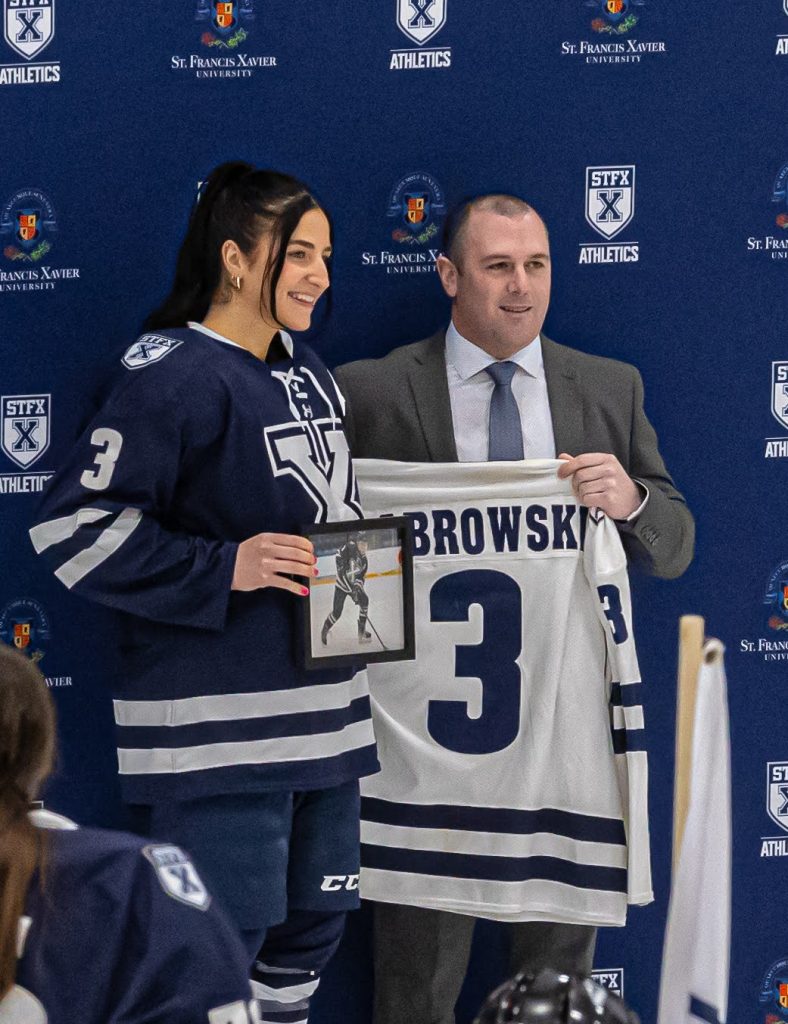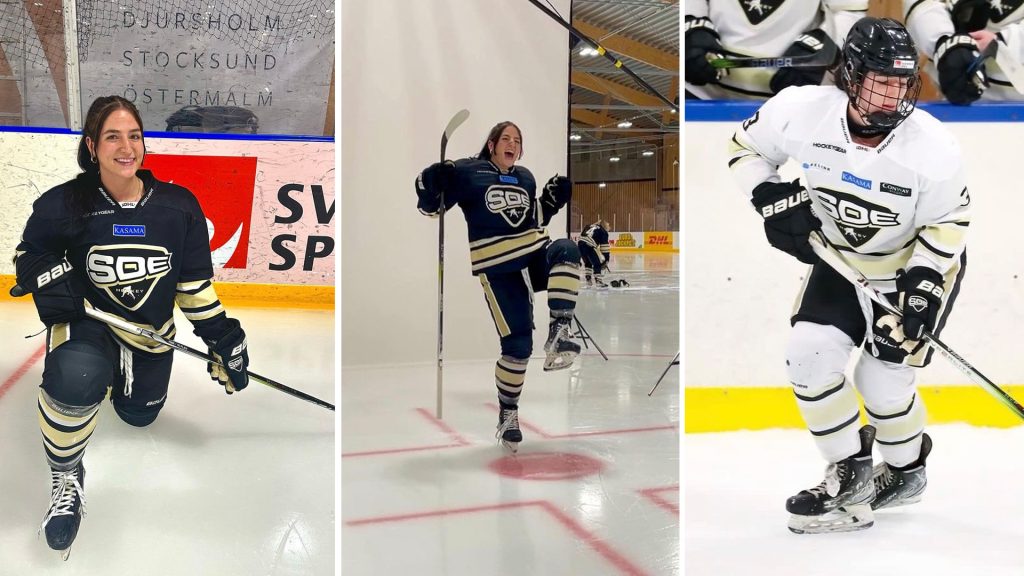My name is Lauren Dabrowski, a 22-year-old hockey player from the small town of Tiny in Ontario.
Growing up in a hockey-centric family, my brother Jacob and I, inspired by our love for the sport, spent endless hours at the rink, watching Leafs games, playing mini sticks, and braving freezing temperatures for pond hockey. Hockey has been my lifelong passion, shaping my leadership skills, work ethic, and perseverance. Despite facing challenges due to my physical disability – Congenital Short Femur – diagnosed at the age of 3, I’ve embraced the highs and navigated the hurdles, making enduring friendships and creating lasting memories along the way.
Congenital Short Femur is a condition where one of your femurs is shorter than the other. My left femur was 5 cm shorter than my right, causing me to walk on my left toes to compensate for the disparity in length. At only five years old, I experienced my first of seven surgeries. The surgery involved an attempt to lengthen my left leg by breaking the bone in half and inserting a fixator. This fixator extended from my femur, and we had to turn it every night for three months until my bone lengthened. Unfortunately, the first two attempts were unsuccessful, as while my left leg was trying to catch up to my right, my right leg was still growing. At twelve years old, we reattempted the surgery which was successful as I gained just over 3 cm, leaving around a 1.5 cm difference between my two legs. However, complications arose, including a bone-eating disease caused by a metal rod, necessitating immediate surgery to remove that rod and avoid possible infection and the potential loss of my leg.
“When faced with challenges, instead of giving up, I had a mindset of ‘I’ll prove you wrong.'”
Despite facing numerous surgeries, I never allowed these challenges to define me, always adapting, adjusting to daily routines, and continuing to pursue my love for hockey.
However, one of my biggest challenges was entering Junior hockey. I was unfortunately cut from my first junior team and was told it was because I wasn’t a good enough skater to keep up in the league. Since I was born with a physical disability, my skating was never my strong suit. I’ve always had to work extra hard to not only be the best that I can be but also make sure I don’t let my disability get in the way of my dream. After receiving the news, I was heartbroken, but I didn’t give up. I persevered and joined another Junior team, determined to prove my capabilities. This setback instilled a mindset of resilience, pushing me to work extra hard to overcome obstacles and avoid making excuses. I focused on my skating skills to ensure that was no longer a weak spot in my game. When faced with challenges, instead of giving up, I had a mindset of “I’ll prove you wrong”.
My journey continued as I followed my dreams of playing Division 1 at Lindenwood University. But after COVID hit during my freshman year, I decided to make the switch back to Canada to play hockey at St. Francis Xavier University in Nova Scotia, where I excelled in USports, earning back-to-back All-Star recognitions as well as becoming an AUS All-Star.
The challenges persisted. With my left leg being underdeveloped, it has caused a lot of hip issues as I’ve gotten older. In my third year of University, my athletic therapist sent me to go get imaging on my left leg as I was in a lot of discomfort. To my surprise, I was later diagnosed with hip dysplasia in my left hip and in my left knee, they found that I have no ACL and both meniscus torn. The doctor told me I would need surgery to fix my hip which required them going in and breaking my pelvis, resulting in a year of recovery and not being able to play hockey again. With this news being dropped on me as I finished my 3rd year going into playoffs, I was devastated. I didn’t know what to think. Something inside me knew this couldn’t be the end. I had gone through so much and this was just another obstacle that I needed to overcome.
“No matter the setbacks I faced, I was able to come out on top.”
Months went by as we prepared for surgery and my doctor later informed me that the surgery may not resolve all of my pain due to the amount of arthritis built up in my hip. Instead, we opted to do a hip replacement down the road and just manage the current pain with pain meds and cortisone shots. I was very happy with this news and my first question to him was, “Can I still play hockey?”. He answered, “Yes”. I was ecstatic! I ended up staying at my University that summer to continue my training and be the best I could be. That next season, I was named 1st team All Canadian, 1st team AUS All-Star, was leading points for defenseman in USports and was 4th in the country in total points. No matter the setbacks I faced, I was able to come out on top. I was determined to prove people wrong, that even though I had a disability and was in pain more days than not, I was one of the best.
All that to say, my journey has been a constant mental and physical challenge. From modifying workouts to using a lift on my skate to skate without a limp, each step demanded extra effort. Facing mental hurdles, I consistently pushed myself beyond the norm, determined not to let my disability define or limit me. My goal was always to excel, refusing to be viewed differently due to my challenges.
With my success at University, I was able to achieve another dream of mine, playing Professional hockey. I signed with the Metropolitan Riveters in the PHF and began training as soon as possible. To my disappointment, we later received the news that all contracts were voided due to a league buyout. However, this setback became an opportunity as I embraced a contract with the SDE in the SDHL, which led me to Stockholm, Sweden.
I’m really enjoying my time here, life in Sweden is beautiful. It reminds me of Canada in some ways with the weather and the beautiful nature. Not many people get the opportunity to come here and play hockey, so I’m very grateful for this experience. We have great insurance plans so I’m fortunate to continue treatment on my hip, allowing me to perform at my best.
In regards to training, I have to modify some off-ice exercises, which allows me to still get the most out of my workouts. Being a professional athlete, especially with my medical history, I need to make sure I do everything for my body to keep it in peak condition, whether that be eating properly or going to therapy.
Reflecting on my journey, my advice to the youth is rooted in self-belief. You need to believe in yourself before expecting others to believe in you. You have to be your biggest supporter anywhere you go, especially when faced with doubt. I’ve had a lot of people doubt me in my career, but I always stuck to my beliefs of knowing that if I put the work in and be the best I can be. Whether getting cut from a team or experiencing a tough game, resilience is key. Pick yourself back up and figure out what you can do better to get where you want to be. Embrace the criticism as a tool for improvement rather than a setback.
I’ve learned that to excel, you have to invest extra effort. If you can outwork your competition and have the competitive edge to get better, you will excel in what you want to do. My commitment involved countless hours perfecting skills in my driveway. I vividly recall my dad emphasizing “the rhythm of the motion,” guiding me to practice the shot’s rhythm before introducing the puck. My life’s mantra has been that anything is possible with genuine belief, but the work must follow. Natural talent has its limits; it’s the unwavering commitment to hard work that sets you apart.
My journey was marked by challenges posed by my disability, but that obstacle only fuelled my determination to overcome physical barriers. It stands as proof that with resilience and dedication, one can surpass expectations even in the face of adversity.



